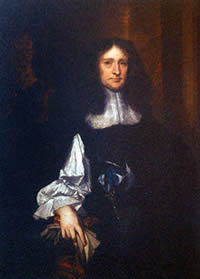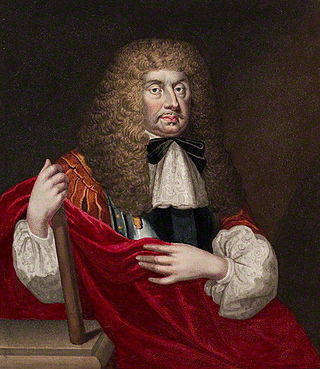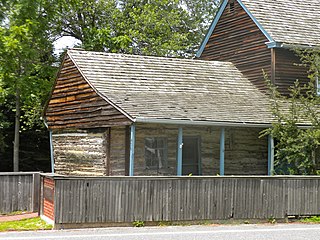Concession and Agreement (full title: The Concession and Agreement of the Lords Proprietors of the Province of New Caesarea, or New Jersey, to and With All and Every the Adventurers and All Such as Shall Settle or Plant There) was a 1664 document that provided religious freedom in the colony of New Jersey. It was issued as a proclamation for the structure of the government for the colony written in 1664 by the two proprietors, Lord John Berkeley and Sir George Carteret.
The document promised religious freedom to all inhabitants of New Jersey, and also declared that the proprietors would be in charge of appointing the provincial governors. The first such governor to be appointed was Philip Carteret. The goal of the document was to entice more settlers to farm in New Jersey, so that the two proprietors could earn more profit by collecting quit-rents, annual fees paid on granted lands. To encourage such settlement, they allowed religious freedom, which was not available under the policies of the English government.

Robert Barclay was a Scottish Quaker, one of the most eminent writers belonging to the Religious Society of Friends and a member of the Clan Barclay. He was a son of Col. David Barclay, Laird of Urie, and his wife, Lady Katherine Barclay. Although he himself never lived there, Barclay was titular governor of the East Jersey colony in North America through most of the 1680s.

West Jersey and East Jersey were two distinct parts of the Province of New Jersey. The political division existed for 28 years, between 1674 and 1702. Determination of an exact location for a border between West Jersey and East Jersey was often a matter of dispute.

The Province of East Jersey, along with the Province of West Jersey, between 1674 and 1702 in accordance with the Quintipartite Deed, were two distinct political divisions of the Province of New Jersey, which became the U.S. state of New Jersey. The two provinces were amalgamated in 1702. East Jersey's capital was located at Perth Amboy. Determination of an exact location for a border between West Jersey and East Jersey was often a matter of dispute.

Vice-Admiral Sir George Carteret, 1st Baronet was a royalist statesman in Jersey and England, who served in the Clarendon Ministry as Treasurer of the Navy. He was also one of the original lords proprietor of the former British colony of Carolina and New Jersey. Carteret, New Jersey, as well as Carteret County, North Carolina, both in the United States, are named after him. He acquired the manor of Haynes, Bedfordshire, in about 1667.

John Berkeley, 1st Baron Berkeley of Stratton of Berkeley House in Westminster and of Twickenham Park in Middlesex, was an English royalist soldier, politician and diplomat, of the Bruton branch of the Berkeley family. From 1648 he was closely associated with James, Duke of York, and rose to prominence, fortune, and fame. He and Sir George Carteret were the founders of the Province of New Jersey, a British colony in North America that would eventually become the U.S. state of New Jersey. The territorial designation of his title refers to his role at the Battle of Stratton, Cornwall, in 1643 at which the Royalists destroyed Parliament's field army in Devon and Cornwall.

Sir Edmund Andros was an English colonial administrator in British America. He was the governor of the Dominion of New England during most of its three-year existence. At other times, Andros served as governor of the provinces of New York, East and West Jersey, Virginia, and Maryland.

The Middle Colonies were a subset of the Thirteen Colonies in British America, located between the New England Colonies and the Southern Colonies. Along with the Chesapeake Colonies, this area now roughly makes up the Mid-Atlantic states.

The Province of New Jersey was one of the Middle Colonies of Colonial America and became the U.S. state of New Jersey in 1776. The province had originally been settled by Europeans as part of New Netherland but came under English rule after the surrender of Fort Amsterdam in 1664, becoming a proprietary colony. The English renamed the province after the island of Jersey in the English Channel. The Dutch Republic reasserted control for a brief period in 1673–1674. After that it consisted of two political divisions, East Jersey and West Jersey, until they were united as a royal colony in 1702. The original boundaries of the province were slightly larger than the current state, extending into a part of the present state of New York, until the border was finalized in 1773.

The Province of Carolina was a province of the Kingdom of England (1663–1707) and later the Kingdom of Great Britain (1707–1712) that existed in North America and the Caribbean from 1663 until partitioned into North and South on January 24, 1712. It consisted of all or parts of present-day Alabama, Florida, Georgia, Mississippi, North Carolina, South Carolina, Tennessee, and the Bahamas.
A lord proprietor is a person granted a royal charter for the establishment and government of an English colony in the 17th century. The plural of the term is "lords proprietors" or "lords proprietary".

Philip Carteret; French: Philippe de Carteret; (1639–1682) was the first Governor of New Jersey, from 1665 to 1673 and governor of East New Jersey from 1674 to 1682.

European colonization of New Jersey started soon after the 1609 exploration of its coast and bays by Henry Hudson. Dutch and Swedish colonists settled parts of the present-day state as New Netherland and New Sweden.
Thomas Rudyard was a Quaker lawyer in London before moving to America and being appointed deputy governor of East Jersey and the first Attorney General of the English Province of New York, the predecessor position to the Attorney General of New York State and the successor position to an analogous office under the Dutch colonial government of New Netherlands.

The Frame of Government of Pennsylvania was a proto-constitution for the Province of Pennsylvania, a proprietary colony granted to William Penn by Charles II of England. The Frame of Government has lasting historical importance as an important step in the development of American and world democracy.
Originally, the state of New Jersey was a single British colony, the Province of New Jersey. After the English Civil War, Charles II assigned New Jersey as a proprietary colony to be held jointly by Sir George Carteret and John Berkeley, 1st Baron Berkeley of Stratton. Eventually, the collection of land fees, or quit-rents, from colonists proved inadequate for colonial profitability. Sir George Carteret sold his share of the colony to the Quakers in 1673. Following the sale, the land was divided into East and West Jersey. In 1681, West Jersey adopted a constitution. In 1683, East Jersey adopted one as well. In 1702, the colonies were united again under Anne, Queen of Great Britain, and adopted a constitution in 1776.

The situation of the Catholic Church in the Thirteen Colonies was characterized by an extensive religious persecution originating from Protestant sects, which would barely allow religious toleration to Catholics living on American territory. Nonetheless, Catholics were a part of America's history from the beginning, especially in Maryland, a colony founded by Catholics.

The New York – New Jersey Line War was a series of skirmishes and raids that took place for over half a century between 1701 and 1765 at the disputed border between two American colonies, the Province of New York and the Province of New Jersey.
The New Jersey Provincial Council was the upper house of the New Jersey Legislature under colonial rule until it was replaced by the New Jersey Legislative Council under the New Jersey Constitution of 1776.

The East New Jersey Provincial Council or Governor's Council was the upper house of the East New Jersey Legislature under proprietary rule until the surrender of the right of government to The Crown, and Queen Anne's acceptance.